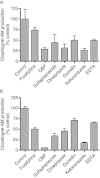The paraoxonase-1 pathway is not a major bioactivation pathway of clopidogrel in vitro
- PMID: 22428615
- PMCID: PMC3448899
- DOI: 10.1111/j.1476-5381.2012.01946.x
The paraoxonase-1 pathway is not a major bioactivation pathway of clopidogrel in vitro
Abstract
Background and purpose: Clopidogrel is a prodrug bioactivated by cytochrome P450s (CYPs). More recently, paraoxonase-1 (PON1) has been proposed as a major contributor to clopidogrel metabolism. The purpose of this study was to assess the relative contribution of CYPs and PON1 to clopidogrel metabolism in vitro.
Experimental approach: Clopidogrel metabolism was studied in human serum, recombinant PON1 enzyme (rePON1), pooled human liver microsomes (HLMs), HLMs with the CYP2C19*1/*1 genotype and HLMs with the CYP2C19*2/*2 genotype. Inhibition studies were also performed using specific CYP inhibitors and antibodies. Clopidogrel and its metabolites were measured using LC/MS/MS method.
Key results: PON1 activity was highest in the human serum and there was no difference in PON1 activity between any of the HLM groups. The production of clopidogrel's active metabolite (clopidogrel-AM) from 2-oxo-clopidogrel in pooled HLMs was approximately 500 times that in serum. When 2-oxo-clopidogrel was incubated with rePON1, clopidogrel-AM was not detected. Clopidogrel-AM production from 2-oxo-clopidogrel was lower in CYP2C19*2/*2 HLMs compared with CYP2C19*1/*1 HLMs, while PON1 activity in HLMs with both genotypes was similar. Moreover, incubation with inhibitors of CYP3A, CYP2B6 and CYP2C19 significantly reduced clopidogrel bioactivation while a PON1 inhibitor, EDTA, had only a weak inhibitory effect.
Conclusion and implications: This in vitro study shows that the contribution of PON1 to clopidogrel metabolism is limited at clinically relevant concentrations. Moreover, CYP2C19, CYP2B6 and CYP3A play important roles in the bioactivation of clopidogrel.
© 2012 The Authors. British Journal of Pharmacology © 2012 The British Pharmacological Society.
Figures







References
-
- Ancrenaz V, Daali Y, Fontana P, Besson M, Samer C, Dayer P, et al. Impact of genetic polymorphisms and drug-drug interactions on clopidogrel and prasugrel response variability. Curr Drug Metab. 2010;11:667–677. - PubMed
-
- Bouman HJ, Schomig E, van Werkum JW, Velder J, Hackeng CM, Hirschhauser C, et al. Paraoxonase-1 is a major determinant of clopidogrel efficacy. Nat Med. 2011;17:110–116. - PubMed
-
- Clarke TA, Waskell LA. The metabolism of clopidogrel is catalyzed by human cytochrome P450 3A and is inhibited by atorvastatin. Drug Metab Dispos. 2003;31:53–59. - PubMed
-
- Combescure C, Fontana P, Mallouk N, Berdague P, Labruyere C, Barazer I, et al. Clinical implications of clopidogrel non-response in cardiovascular patients: a systematic review and meta-analysis. J Thromb Haemost. 2010;8:923–933. - PubMed
MeSH terms
Substances
LinkOut - more resources
Full Text Sources
Molecular Biology Databases
Miscellaneous

